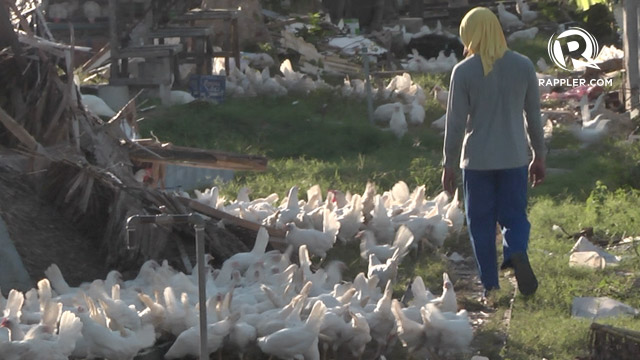SUMMARY
This is AI generated summarization, which may have errors. For context, always refer to the full article.

TACLOBAN CITY, Philippines – Aid is pouring in for victims of typhoon Yolanda.
But to get people back on their feet, survivors say what they need is livelihood.
Voltaire Tupaz reports.
Jobless, homeless, and hungry, 25-year-old Rachel Asopre leaves Tacloban City with her 3 children. A wall of water destroyed their house in a coastal village during the typhoon.
RACHEL ASOPRE, TYPHOON YOLANDA SURVIVOR: Mapa-Manila la anay kami kay waray gud na ngadto ha Tacloban intawon nakakaon it kabataan. Waray pa gud tubig. Waray na tubig. (We will temporarily leave Tacloban because my children had nothing to eat there. There’s no more water.)
Rachel breathes a sigh of relief as soon as the barge docks at the Matnog port. But beyond the port, she doesn’t know what awaits her.
RACHEL ASOPRE, TYPHOON YOLANDA SURVIVOR: Kung ano la it makukuan ha akon nga trabaho. (Any work that I will find.)
Before the typhoon, she sold fried chicken to earn a living. That is now over.
The International Labor Organization reports at least 5.2 million workers lost their livelihood. International humanitarian groups are encouraging survivors to stay in their towns for help is on the way.
MARCO BOASSO, INTERNATIONAL ORGANIZATION FOR MIGRATION CHIEF OF MISSION: We need to inform these people that help is coming and that there are plans and that there is a lot that is getting in to the affected area and that they should not be that desperate in the sense that they are moving around without a direction and landing in Villamor or landing elsewhere in Metro Manila or Cebu is not gonna be that helpful and that is one of the gaps we were are discussing with DSWD.
Job creation ushers in recovery in affected areas. The ILO and the Department of Labor say emergency employment should be prioritized in disaster response, but they admit they lack funds.
RUTH GEORGET, ILO PROGRAM OFFICER: The real challenge we face within the livelihood cluster is the limited funding which now stands at only 6%
The exodus of people from Tacloban continues even if international support is pouring in. Relief goods will not be enough. Experts say victims will continue to feel helpless and hopeless if they do not find a livelihood soon.
Voltaire Tupaz, Rappler, Manila. – Rappler.com
The Long Road to Tacloban
Rappler has set up a base in Tacloban to gather stories in Leyte and Eastern Samar, especially in the towns and villages that sufficient aid and most media have yet to reach.
On November 14, they set out for Tacloban – by land – from our headquarters in Pasig City. The 36-hour trip took them through the provinces most heavily devastated by Super Typhoon Yolanda (Haiyan). Here, they shared with us what they saw along the way, capturing images of destruction and despair, narrating stories of anguish, hope, and heroism.
Their journey continues. They are finding people. The stories keep coming. Their and these people’s voices are here.
Follow their story here
Help the victims of Typhoon Yolanda (international codename: Haiyan). Visit Rappler’s list ofongoing relief operations in your area. Tell us about your relief and recovery initiatives, emailmove.ph@rappler.com or tweet us @moveph
Visit rappler.com/typhoon-yolanda for the latest updates on Typhoon Yolanda.
Want to help? Read these:
- #ReliefPH: Victims of Typhoon Yolanda need your help
- #YolandaPH (Haiyan): Filipinos worldwide heed call to action
- Why Paypal may lock Haiyan relief accounts
- Yolanda (Typhoon Haiyan): Aid, donations for international community
Other ways to help out:
Add a comment
How does this make you feel?
There are no comments yet. Add your comment to start the conversation.